
Eleotridae is a family of fish commonly known as sleeper gobies, with about 34 genera and 180 species. Most species are found in the tropical Indo-Pacific region, but there are also species in subtropical and temperate regions, warmer parts of the Americas and near the Atlantic coast in Africa. While many eleotrids pass through a planktonic stage in the sea and some spend their entire lives in the sea; as adults, the majority live in freshwater streams and brackish water. One of its genera, Caecieleotris, is troglobitic. They are especially important as predators in the freshwater stream ecosystems on oceanic islands such as New Zealand and Hawaii that otherwise lack the predatory fish families typical of nearby continents, such as catfish. Anatomically, they are similar to the gobies (Gobiidae), though unlike the majority of gobies, they do not have a pelvic sucker.
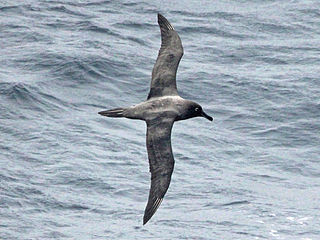
The sooty albatross is a species of marine bird belonging to the albatross family Diomedeidae. It is a medium-sized albatross that sports a sooty-brown or sooty-black color. It can be found in the southern Atlantic Ocean, the southern Indian Ocean, and the Southern Ocean. This bird scavenges for squid, fish, and carrion. Like other albatrosses, these birds mate for life and return to the same breeding spots every season. A single pair will mate every other year on a variety of islands in the southern Atlantic Ocean and the southern Indian Ocean islands. This bird is an endangered species and conservation efforts are taking place.
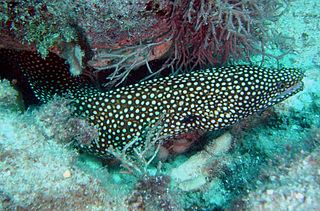
The turkey moray ,also known as the guineafowl moray or as the white-mouth/whitemouth moray is a species of marine fish in the family Muraenidae.

Butis butis, the crazy fish, duckbill sleeper, or upside-down sleeper, is a species of sleeper goby that are native to brackish and freshwater coastal habitats of the Indian Ocean and the western Pacific Ocean from the African coast to the islands of Fiji. They prefer well-vegetated waters and can frequently be found in mangrove swamps. They are small, drably-colored fish, reaching a maximum length of only 15 cm (5.9 in). They are predatory and are known for their behavior of swimming vertically – or even upside down – while hunting.

Eleotris melanosoma, the broadhead sleeper or dusky sleeper, is a species of fish in the family Eleotridae native to marine, fresh, and brackish waters from coastal eastern Africa through southern Asia to the islands of the western Pacific Ocean. This species can reach a length of 26 cm (10 in). It is of minor importance to local commercial fisheries. This species has been introduced to the Panama Canal Zone.
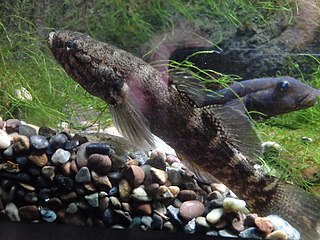
Eleotris sandwicensis, the Sandwich Island sleeper, Hawaiian sleeper or oopu, is a species of fish in the family Eleotridae endemic to the Hawaiian Islands, where it can be found in marine, fresh, and brackish waters around the coast. Due to this capability of migrating between different marine environments, they are amphidromous. This fish can reach a length of 33 cm (13 in). It is locally important to commercial fisheries and is also used as bait by fishermen after larger fishes. In the Hawaiian language, the fish is also known as oʻopu, ʻoau, ʻowau, and hiʻu kole.
Eleotris vomerodentata is a species of fish in the family Eleotridae endemic to Madagascar, where it is only known to occur in fresh waters. This species can reach a length of 7.8 cm (3.1 in). Eleotris have similar features, generally, but there are ways to distinguish an Eleotris vomerodentata. The head, preoperculum, body and abdomen are beige to light brown. The fins are whitish-beige in color. The most common distinguishing feature is the presence of teeth in the vomer.

Gymnothorax miliaris, the goldentail moray, bastard eel, or conger moray, is a species of marine fish in the family Muraenidae.

The whitemargin moray or the white-edged moray, Gymnothorax albimarginatus, is a species of marine fish in the family Muraenidae.
The yellowmouth grouper, also known as the crossband rockfish, grey mannock, hamlet, harlequin rockfish, princess rockfish, rockfish, salmon grouper, salmon rock fish or scamp, is a species of marine ray-finned fish, a grouper from the subfamily Epinephelinae which is part of the family Serranidae, which also includes the anthias and sea basses. It is found in the Caribbean and in the tropical waters of the Atlantic Ocean. It is also found in pockets in Brazil. It is a fairly large fish and it gets its name from the yellow around its mouth.

Eleotris is a genus of fish in the family Eleotridae with a circumglobal distribution in tropical and subtropical regions.

Sicyopterus griseus, the Clown goby, is a species of goby endemic to India and Sri Lanka, where it is found in estuaries, blackwaters, and fresh waters. The populations within Sri Lanka is not yet internationally accepted, due to lack of evidences. This species can reach a length of 9.7 centimetres (3.8 in) SL.
Redigobius balteatus, the rhinohorn goby, girdled goby or skunk goby, is a species of goby native to the Sri Lanka, Philippines, Malaysia, Indonesia, Japan, New Guinea, Madagascar, and Mozambique. This species inhabits coastal estuaries, lakes and freshwater streams. It can reach a length of 3.8 centimetres (1.5 in) SL.
Microphis ocellatus, the ocellated pipefish, is a species of fish in the family Syngnathidae. It is found only in Indonesia and Sri Lanka. The species measured 12.5 centimetres (4.9 in) SL in length.
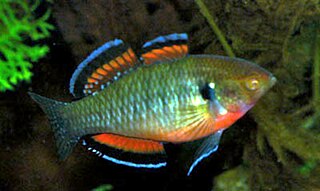
Hypseleotris compressa, the empire gudgeon, is a species of Gobiiform fish in the family Eleotridae endemic to Australia and south-central New Guinea.
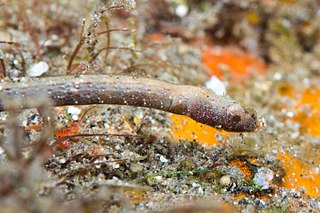
Halicampus dunckeri or also commonly known as the Duncker's pipefish or ridgenose pipefish is a species of fish in the family Syngnathidae.

Mycteroperca fusca, the Island grouper or comb grouper, is a species of grouper from the family Serranidae which is endemic to the Macaronesian Islands in the eastern Atlantic. It is classified as Vulnerable in The IUCN Red List of Endangered Species.
Oxyeleotris nullipora, the poreless gudgeon, is a gudgeon of the genus Oxyeleotris, a freshwater fish found in Australia and Papua New Guinea.
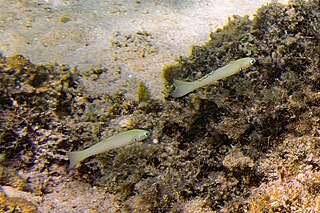
Ptereleotris microlepis is a species of the fish family Gobiidae. It is widely distributed in a variety of nearshore habitats of the Indian and Pacific Oceans.















